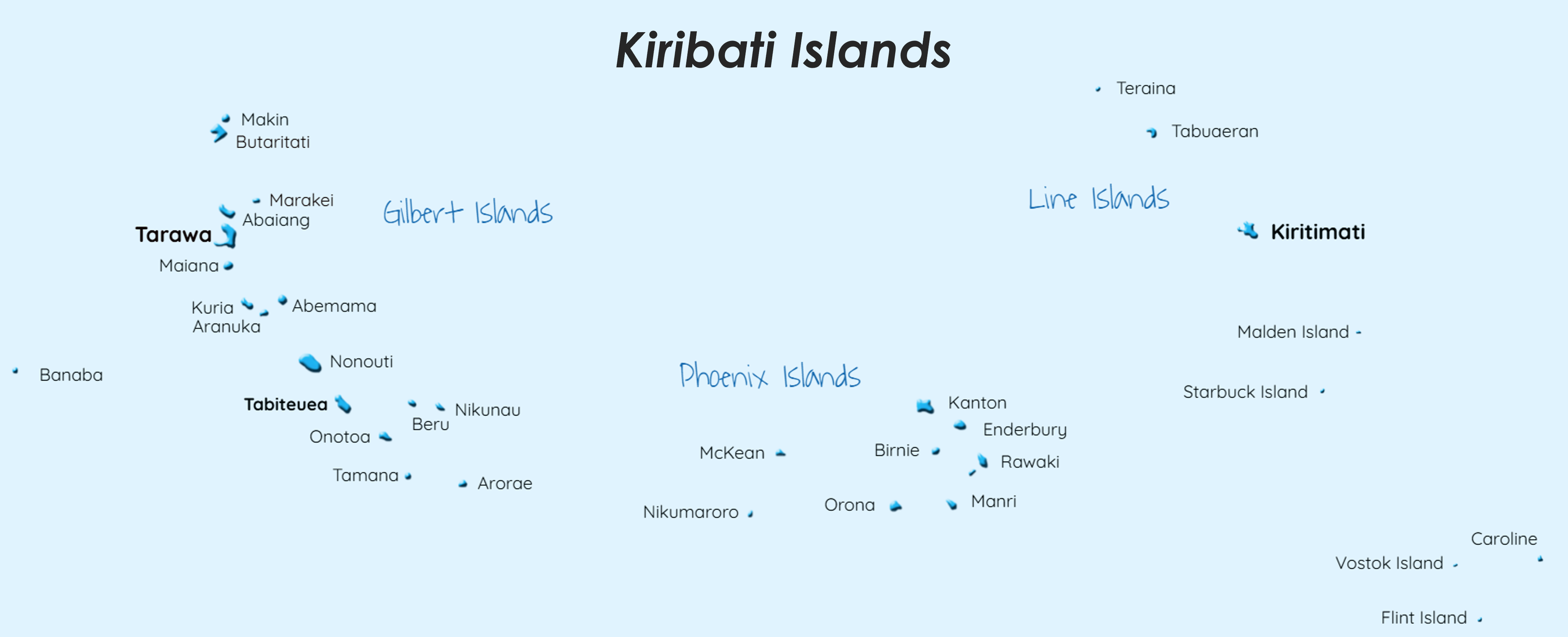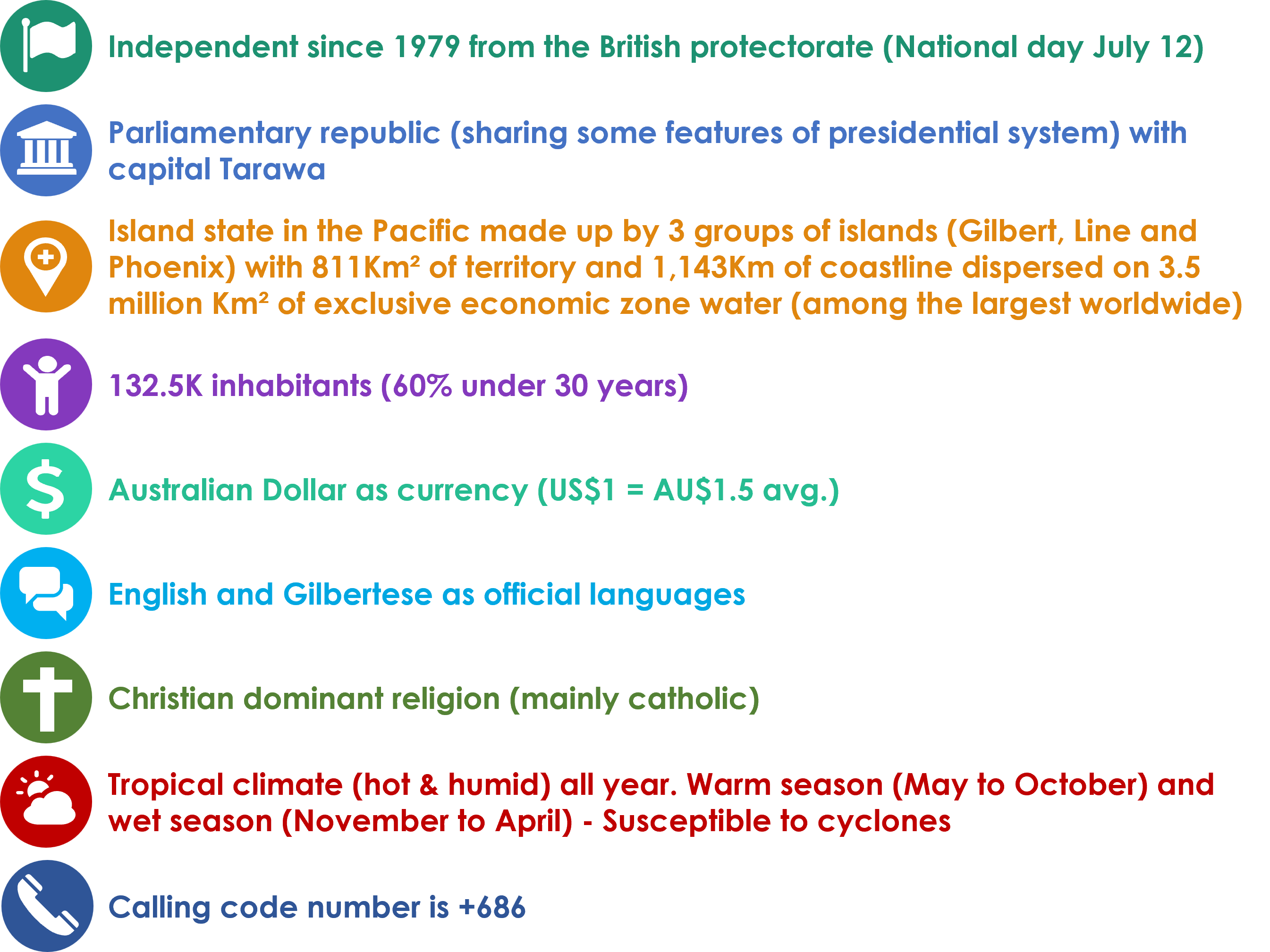Kiribati at a glance

A unique island nation in the heart of the Pacific
Kiribati is a sovereign nation of scattered atolls and coral islands, offering investors and visitors a distinct blend of natural beauty, cultural richness, and strategic location. With a peaceful society, a young and growing population, and a strong commitment to sustainability, Kiribati is a country full of potential—ready to engage with the world and welcome responsible investment.
🌍 Location & geography
Kiribati is located in the central Pacific Ocean, with territory stretching across the equator and the International Date Line. It comprises 33 coral atolls and reef islands, divided into three island groups: the Gilbert Islands, Phoenix Islands, and Line Islands. Despite its small landmass of 811Km², Kiribati covers 1,143Km of coastline dispersed on 3.5 million Km², making it one of the largest Exclusive Economic Zones (EEZs) in the world.
Its strategic position between Asia, Australia, and the Americas gives it a strategic advantage for regional connectivity and Pacific cooperation, making it a natural player in the blue economy and climate diplomacy.


👥 People and society
Kiribati has an estimated population of 132,500, making it the 5th most populous Pacific Island State. A remarkable 60% of the population is under the age of 30, offering a dynamic and long-term labor pool for investors.
The I-Kiribati (noun) society is centered around family, tradition, and collective well-being, with decisions often made at the community level.
English and Gilbertese are the official languages, supporting both international engagement and cultural continuity. The society is peaceful, close-knit, and guided by a rich cultural heritage—making Kiribati a welcoming and stable place to live and work.
🏛️Government and international relations
Kiribati is a sovereign, democratic republic with a stable political system that blends elements of both parliamentary and presidential models. The President, elected from among nominees selected by Parliament, serves as both Head of State and Government. The unicameral Parliament consists of 45 members elected every four years, and the country follows the Westminster system as a member of the Commonwealth.
The legal framework is based on English common law, complemented by customary law. Government administration is centered in South Tarawa, with key ministries located in Betio, Bairiki, and Bikenibeu, while the House of Parliament is located in Ambo. Local Island Councils oversee governance in North Tarawa and the outer islands, ensuring community representation across the country.
Kiribati maintains strong international relations and is an active member of global and regional bodies, including the United Nations, Pacific Islands Forum (PIF), Commonwealth of Nations, World Bank, and Asian Development Bank (ADB). The country is also a prominent voice in global climate advocacy, championing the concerns of Small Island Developing States (SIDS) in major international forums.
💼 Economy and investment climate
Kiribati’s economy is driven by fisheries, marine services, offshore labor mobility (remittances), development assistance and copra. There is also increasing interest in tourism, renewable energy, and climate-resilient infrastructure.
The country uses the Australian Dollar (AUD) as its official currency, providing monetary stability. Kiribati also benefits from preferential trade access to major markets through partnerships and trade agreements such as GSP-LDC, PACER Plus, and EU-Pacific EPA. Due to limited domestic production, Kiribati relies heavily on imports for most of its food and manufactured goods.
🎓 Human capital
Kiribati’s educated and youthful workforce is one of its key advantages. The country boasts high literacy levels (90.6%) above the global average (86.8%) and a strong emphasis on education, supported by significant public investment (16.6% of GDP), the highest in the Pacific, and far exceeding the global average (3.8%).
National institutions offer technical and tertiary education across sectors such as health, education, maritime training, and skilled trades—producing a workforce that is adaptable, motivated, and increasingly skilled. This positions Kiribati as an ideal destination for businesses looking to grow alongside a capable labor force.
✈️ Connectivity & infrastructure
Kiribati is connected through Bonriki International Airport in South Tarawa and in less proportion by Cassidy International Airport, with regular flights to Fiji, Nauru, Marshall Islands, and Hawaii. Efforts are underway to expand infrastructure and digital connectivity, including improvements in ports, renewable energy systems, and telecommunications. These investments aim to reduce geographic barriers and increase economic inclusion, while supporting sectors like transport, logistics, ICT, and green infrastructure.
🕒 Time Zones in Kiribati
Kiribati is uniquely positioned across three standard time zones:
- Gilbert Islands Time (GMT+12)
- Phoenix Islands Time (GMT+13)
- Line Islands Time (GMT+14)
Prior to 1994, the International Date Line split the country, creating a 23-hour difference between its eastern and western islands. To unify the nation and streamline coordination, President Hon. Teburoro Tito shifted the Date Line eastward. This historic move brought all of Kiribati into the same calendar day, reducing the time gap to just two hours between the island groups. Thanks to this decision, Kiribati became the first country in the world to welcome the new millennium. To mark this once-in-a-lifetime moment, Caroline Island was renamed Millennium Island for the year 2000.
📌Quick facts
